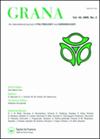Palynological characterisation of palm honey (Sabal yapa) produced in Yucatan (Mexico)
IF 1
4区 生物学
Q4 PLANT SCIENCES
引用次数: 1
Abstract
Abstract The palm honey (Sabal yapa C. Wright ex Becc.) (Sabal honey henceforth) is one of 22 unifloral honeys recognised in the Yucatan Peninsula. This honey is harvested in February and March when Sabal yapa bloom but encompasses other important melliferous plants during the harvest season. A melissopalynological study of 24 honey samples from Tizimín, Yucatan (Mexico) was used to determine if Sabal honey is monofloral or multifloral, and to investigate the pollen contribution of other plants. Consequently, we determined the plant resources foraged by Apis mellifera. After analysis, 54 different pollen types were identified with the number of pollen types per honey sample ranging between nine and 21, with a mean of 14.75. Asteraceae and Fabaceae were the most diverse families and represented the highest percentage of contribution in pollen spectra. Sabal yapa pollen had a mean content of 56.9% (with a range of 45.4% to 84%). Bursera simaruba, Haematoxylum campechianum, Piscidia piscipula and Viguiera dentata were categorised as secondary pollen. Important minor pollen corresponded to Caesalpinia gaumeri, Ceiba pentandra, Pisonia aculeata, Thouinia paucidentata, and Trixis inula. Pollen composition revealed details of not only the rich native flora that accompanies Sabal yapa, but traditional human activities that occur around the apiaries. As expected, pollen of nectariferous species predominate in the samples, but also a number of nectarless species were found. Honeybees foraged mostly in trees present in remnants of primary vegetation, or at its different succession stages. Sabal honey could be labelled as monofloral.墨西哥尤卡坦产棕榈蜜(Sabal yapa)孢粉学特征
摘要棕榈蜂蜜(Sabal yapa C.Wright ex Becc.)(从此称为Sabal蜂蜜)是尤卡坦半岛公认的22种单一品种蜂蜜之一。这种蜂蜜在2月和3月Sabal yapa开花时收获,但在收获季节也包括其他重要的含醇植物。对来自尤卡坦(墨西哥)蒂齐明的24个蜂蜜样本进行了花粉学研究,以确定萨巴尔蜂蜜是单花还是多花,并调查其他植物的花粉贡献。因此,我们确定了由意大利蜜蜂采集的植物资源。经过分析,鉴定出54种不同的花粉类型,每个蜂蜜样本的花粉类型数量在9到21之间,平均为14.75。菊科和蚕豆科是最多样化的科,在花粉光谱中的贡献率最高。沙巴花粉的平均含量为56.9%(范围为45.4%至84%)。将西马铃花、红毛菊、豌豆花和齿花属次生花粉。重要的次要花粉对应于Caesalpia gaumeri、Ceiba pentandra、Pisonia acureata、Thouinia paucidentata和Trixis inula。花粉成分不仅揭示了萨巴尔亚帕丰富的本土植物群的细节,还揭示了养蜂场周围发生的传统人类活动的细节。不出所料,在样本中,有蜜腺物种的花粉占主导地位,但也发现了一些无蜜腺物种。蜜蜂主要在原始植被残余的树木中觅食,或在其不同的演替阶段觅食。Sabal蜂蜜可以被标记为单花蜂蜜。
本文章由计算机程序翻译,如有差异,请以英文原文为准。
求助全文
约1分钟内获得全文
求助全文
来源期刊

Grana
生物-植物科学
CiteScore
2.10
自引率
11.10%
发文量
23
审稿时长
>12 weeks
期刊介绍:
Grana is an international journal of palynology and aerobiology. It is published under the auspices of the Scandinavian Palynological Collegium (CPS) in affiliation with the International Association for Aerobiology (IAA). Grana publishes original papers, mainly on ontogony (morphology, and ultrastructure of pollen grains and spores of Eucaryota and their importance for plant taxonomy, ecology, phytogeography, paleobotany, etc.) and aerobiology. All submitted manuscripts are subject to initial appraisal by the Editors, and, if found suitable for further consideration, to peer review by independent, anonymous expert referees. All peer review is single blind and submission is online via ScholarOne Manuscripts.
 求助内容:
求助内容: 应助结果提醒方式:
应助结果提醒方式:


